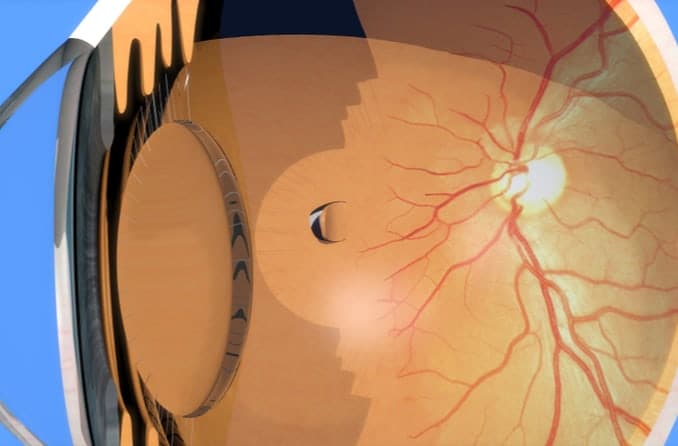The retina is the thin layer of specialized nerve cells that lines the inside of the back of the eye. It’s here that the process of vision begins.
A tear can form in the retina due to trauma or surgery (among other risk factors), which can eventually challenge the functionality of the eye itself.
Even small retinal tears should be taken very seriously, because they can lead to a retinal detachment that may cause permanent vision loss and even blindness.
Symptoms
It is important to note that some retinal tears are asymptomatic, meaning there is nothing to alert you that a problem is developing in your retina. (This is one reason why routine eye exams are so important to keep your eyes healthy — your eye doctor can spot signs of trouble before you are aware of them.)
Of course, there are some key symptoms of retinal tears to take note of as well. Common retinal tear symptoms include:
Sudden onset of eye floaters
Flashes of light
If the condition is associated with retinal detachment or bleeding (vitreous hemorrhage), symptoms can also include the following:
Blurred vision
A dark shadow blocking part of your peripheral vision
Generally, symptoms of a retinal tear or detachment occur in one eye only. But in some cases, it’s possible for both eyes to be affected.
Do not hesitate to contact an eye doctor if you believe you are experiencing symptoms of a retinal tear or another serious eye condition, whether the symptoms are mild, moderate or severe.
RELATED READING: Retinal detachment FAQs
Causes
Retinal tears can occur spontaneously, following trauma to the head or eyes, or after eye surgery.
The vitreous is the gel-like substance that fills the large chamber in the back of the eye (between the lens and the retina). The vitreous is attached to the retina at birth but detaches as the body ages. This process is known as posterior vitreous detachment (PVD), and typically doesn’t cause any serious problems.
However, some people have a more “sticky” vitreous, causing the vitreous to tug on the retina as it separates. When this happens, it can cause a spontaneous tear in the retina. The majority of retinal tears occur this way.
Aside from this spontaneous occurrence, retinal tears can also happen due to trauma or following an eye surgery, such as a vitrectomy or cataract removal.
Risk factors
Who is most susceptible to retinal tears? Many retinal tears are spontaneous, though some factors can play a role in the probability of the condition occurring in some individuals.
Risk factors for retinal tears may include the following:
Pre-existing conditions related to the retina
Trauma or risk of trauma in employment or physical activities
Extreme nearsightedness (myopic retinas can be notably thin)
Family history of retinal detachment
Previous eye surgery, such as a vitrectomy or cataract removal
Advanced age
There is no way to predict if a retinal tear will occur — there is also no way to predict when one will occur.
SEE RELATED: Types of retinal detachment
Diagnosis
A retinal tear can only be diagnosed by your eye doctor. During a comprehensive eye exam, your doctor will dilate your pupils and carefully examine your retinas for any signs of retinal tears.
If a retinal tear is detected, you may then be referred to a retina specialist who will confirm the diagnosis, determine the severity of the tear and recommend an appropriate treatment plan.
Treatment
Because a rip or tear in the retina can lead to a retinal detachment, retinal tears should be evaluated as soon as possible.
How do you care for a retinal tear? Treatment may vary depending on the degree of the condition.
Retinal tear surgery
Some retinal tears are treated with laser eye surgery. During the procedure, a laser is used to seal the edges of the tear. Sealing the tear will help to prevent the condition from worsening or leading to retinal detachment.
Aside from laser surgery, retinal tears may also be treated with a freezing procedure called cryotherapy (cryopexy). Both procedures are out-patient procedures (meaning they don’t require an overnight stay in a hospital and you can go home immediately after the treatment).
SEE RELATED: Retinal tear surgery
Monitoring
If a retinal tear is determined to be mild or low-risk, treatment may not be required — at least not immediately. And sometimes, a scar will form around the border of the retinal tear, which self-heals the tear and eliminates the need for surgical treatment.
That said, any identification of a retinal tear should be evaluated and monitored by an eye doctor and/or retinal specialist during regular eye examinations. A yearly eye exam is the best way to ensure that your retinas are healthy and no further vision problems have occurred or progressed.
READ NEXT: The seriousness of a retinal hole and Retinal vasculitis
